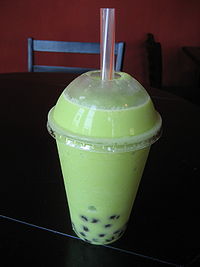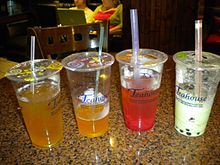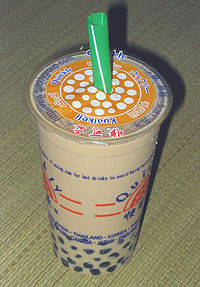- Bubble tea
-
Bubble tea (Boba Tea) 
Bubble teaOrigin Alternative name(s) pearl milk tea, boba milk tea Place of origin Taichung, Taiwan Creator(s) Disputed Dish details Course served Beverage Main ingredient(s) Tapioca starch balls, milk, brewed tea, sugar Bubble tea is the name for pearl milk tea and other similar tea and juice beverages that originated in tea shops in Taichung, Taiwan during the 1980s. Drink recipes may vary, but most bubble teas contain a tea base mixed with fruit (or fruit syrup) and/or milk. Ice-blended versions of the drinks, similar to slushies, are also available, usually in fruit flavors.
One of the famous categories of bubble teas is "pearl milk tea" (also known as "boba milk tea" in parts of America), which contains small chewy balls made of tapioca starch, called "Pearls" in Chinese (also known as "Fenyuan 粉圆" or "Zhenzhu 珍珠"). Pearls made of tapioca are also available in many places.
Bubble tea began its rise to international recognition, spreading from Taiwan to other East Asian countries. It then migrated to Australia, Canada, Chinatowns throughout the United States, and various college towns along the American West Coast. There are also bubble tea cafes in the UK[1] and Europe.
There are many variants of the drink, depending on the types of tea used and ingredients added. The most popular kinds are "green tea with pearls" (泡沫綠茶), "pearl milk tea" (珍珠奶茶), "pearl green milk tea" (珍珠奶綠), "pearl black tea" (珍珠紅茶) and "pearl green tea" (珍珠綠茶), etc.
Contents
Description
Bubble teas are generally of two distinct types: fruit-flavored teas, and milk teas. However, some shops offer hybrid "fruit milk teas." Most milk teas include powdered dairy or non-dairy creamers, but some shops also offer fresh milk as an alternative. Other varieties are 100% crushed-fruit smoothies with pearls and signature ice cream shakes made from local ice cream sources. Many American bubble tea vendors sell "milk smoothies," which are similar to bubble tea but do not contain any tea ingredients. Some small cafés offer sweetener substitutes such as honey, agave, stevia, and aspartame upon special request.
The oldest known bubble tea consisted of a mixture of hot Taiwanese black tea, small tapioca pearls (粉圓), condensed milk, and syrup (糖漿) or honey. Many variations were created, the most common of which is served cold rather than hot. The tea type is frequently replaced. First was bubble green tea, which uses jasmine-infused green tea (茉香綠茶) instead of black tea. Big tapioca pearls (波霸/黑珍珠) were adapted and quickly replaced the small pearls.[2][3] Peach or plum flavoring appeared, then more fruit flavors were added until, in some variations, the tea was removed entirely in favor of real fruit. These fruit versions sometimes contain colored pearls (and/or "jelly cubes" as in the related drink taho), the color chosen to match whatever fruit juice is used. Flavors may be added in the form of powder, fruit juice, pulp, or syrup to hot black or green tea, which is then shaken in a cocktail shaker or mixed with ice in a blender. Cooked tapioca pearls and other mix-ins are added at the end.
Today, one can find shops entirely devoted to bubble tea, similar to the juice bars of the early 1990s. Some cafes use plastic dome-shaped lids, while other bubble tea bars serve it using a machine to seal the top of the cup with plastic cellophane. This allows the tea to be shaken in the serving cup and makes it spill-free until one is ready to drink it. The cellophane is then pierced with an oversized straw large enough to allow the pearls to pass through.
Variants
Each of the ingredients of bubble tea can have many variations depending on the tea house. Typically, different types of black tea, green tea, or even coffee can form the basis of this beverage. The most common black tea varieties are Oolong and Earl Grey, while jasmine green tea is a mainstay at almost all tea houses. Another variation called 鴛鴦 (Simplified - 鸳鸯) (yuanyang, named after the "mandarin duck") originated in Hong Kong and consisting of half black tea and half coffee. Decaffeinated versions of teas are sometimes available when the tea house brews fresh the tea base.
The milk in bubble tea is optional, though many tea houses use it. Some cafes use a non-dairy creamer milk substitute instead of milk because many East Asians are lactose intolerant and because it's both cheaper and easier to store and use than perishable milk.[4] In Western countries, soy milk options are widely available for those who avoid dairy products. This adds a distinct flavor and consistency to the drink.
 Four different Bubble Teas: mango green tea, lychee green tea, strawberry green tea with strawberry jelly, and a coconut cream blend with tapioca.
Four different Bubble Teas: mango green tea, lychee green tea, strawberry green tea with strawberry jelly, and a coconut cream blend with tapioca.
Different flavorings can be added to bubble tea. Some widely available fruit flavors include strawberry, green apple, passion fruit, mango, lemon, watermelon, grape, lychee, peach, pineapple, cantaloupe, honeydew, banana, avocado, coconut, kiwi, and jackfruit. Other popular non-fruit flavors include taro, pudding, chocolate, coffee, mocha, barley, sesame, almond, ginger, lavender, rose, caramel and violet. Some of the sour fruit flavors are available in bubble tea without milk only as the acidity tends to curdle the milk.
Other varieties of the bubble tea drink can include blended drinks. Many stores in the U.S. provide a list of choices to choose from. Some may include coffee-blended drinks, or even smoothies.
Tapioca balls are the prevailing chewy tidbit in bubble tea, but a wide range of other options can be used to add similar texture to the drink. Green pearls have a small hint of green tea flavor, and are chewier than the traditional tapioca balls. Jelly is also used in small cubes, stars, or rectangular strips, with flavors such as coconut jelly, konjac, lychee, grass, mango, and green tea often available at some shops. Rainbow, a fruit mix of konjac, has a pliant, almost crispy consistency. Adzuki bean or mung bean paste, also typical toppings for Taiwanese shaved ice desserts, give the drinks an added subtle flavor, as well as texture. Aloe, egg pudding, sago, and taro balls can also be found in most tea houses, to complete the perfect cup of tea.
Due to its popularity, single-serving packets of black tea (with powdered milk and sugar included) are available as "Instant Boba Milk Tea" in some places.
Bubble tea cafés will also frequently serve drinks without coffee or tea in them. The base for these drinks is flavoring blended with ice, often called Snow Bubble. All mix-ins that can be added to the bubble tea can also be added to these slushie-like drinks. One drawback to them is that the coldness of the iced drink may cause the tapioca balls to harden, making them difficult to suck up through a straw and chew. To prevent this from happening, these slushies must be consumed more quickly than bubble tea.
Occasionally, nata de coco is used in mass-produced bubble tea drinks as a healthier alternative to tapioca starch. Nata de coco is high in dietary fiber and low in cholesterol and fat. The nata de coco is sliced into thin strips to make it easier to pass through a straw.[5]
History
Two shops claim to be the creators of bubble tea. One is Chun Shui Tang teahouse (春水堂) in Taichung, Taiwan, where Liu Han Chie experimented with cold milk tea by adding fruit, syrup, candied yams, and tapioca balls in the early 1980s. Although the drink was not popular at first, a Japanese television show generated interest in it among businessmen, according to the contested originator (春水堂) from Taichung. The drink became well known in most parts of East and Southeast Asia during the 1990s.[2] Although not everyone in Taiwan knows which teahouse the famous drink came from, most know of its origin being Taichung, Taiwan's center-most city. Article: Is this the inventor of bubble tea?
An alternative origin is the Hanlin (翰林) Teahouse in Tainan, Taiwan, owned by Tu Tsong He Hanlin. He made tea using traditional white fenyuan, or tapioca, which has the appearance of pearls, supposedly resulting in the so-called "pearl tea." Shortly after, Hanlin changed the white fenyuan (粉圓) to the black version that is seen most today.
Names
Bubble tea has many other names:
Chinese
- 泡沫紅茶 (pinyin: pàomò hóngchá): "foam red tea," by direct translation, is the drink that is more appropriate for the more literal name of "bubble tea," however the English name, foam tea, is not used much throughout Asia. Consequently, in non-Chinese-speaking Asian countries, "bubble tea" is commonly used to refer to this drink.[6] There is no tapioca in this particular drink. To create this, vendors mix hot or warm tea (in this case, black tea) with syrup/sugar and ice cubes into a cocktail shaker. Then they would shake the shaker either by hand or by machine before it is served. The resulting tea would be covered by a layer of foam/froth and the tea would have a light foamy feel to the taste.[7][8]
- 泡沫奶茶 (pinyin: pàomò nǎichá): "foam milk tea." One of the many variants that is prepared the same way as the "foam red tea," well-shaken before serving.
- 珍珠奶茶 or 珍奶 for short) (pinyin: zhēnzhū nǎichá): "pearl milk tea," or more commonly referred to as bubble tea by most English speakers and overseas Chinese. The "pearl" name originally referred to the small 1/12" tapioca pearls added to the drink. Though most modern vendors serve only the bigger 1/4" pearls, they still use "pearl tea" as the name.[2]
- 波霸奶茶 (pinyin: bōbà nǎichá): "bubble milk tea" and also commonly referred to as boba tea by English speakers and Asian Americans. The name refers to the variant with the bigger, 1/4" tapioca pearls.[2]
- 黑珍珠奶茶 (pinyin: hēi zhēnzhū nǎichá): "black pearl milk tea," since the bigger 1/4'' tapioca pearls are separately sold as "black pearls" (黑珍珠) in markets, this name was the logical first choice and is more popular with the consumers of the drink. "Boba" (波霸) is an alternative name that is less commonly used these days.[3]
- (奶)茶珍珠 (pinyin: (nǎi) chá zhēnzhū): "(milk) tea pearl" (less common)
- 泡泡茶 (pinyin: pào pào chá): used interchangeably with 珍珠奶茶 to refer to "bubble tea" in Singapore.
English
- bubble (milk) tea or drink
- boba (milk) tea or drink
- pearl (milk) tea or drink
- milk pearl tea or drink
- black pearl (milk) tea or drink
- (milk) tea pearl
- bubble cup
- bubble milk
- frubble
- bubcatle (milk) tea or drink
Others
- 보바 드링크, 보바 티, 버블티 (Korean): transliterated "boba drink," "boba tea," "bubble tea"
- タピオカドリンク, タピオカティー (Japanese): transliterated tapiokadorinku translated "tapioca drink"; tapiokatii translated "tapioca tea"
- Trà sữa trân châu (Vietnamese): literally "pearl milk tea"
- ชาไข่มุก, ชานมไข่มุก (Thai): literally "pearl tea" or "pearl milk tea"
- Ságo at Guláman (Tagalog): literally "tapioca pearls and agar"
- Teh Mutiara (Indonesian): literally "pearl tea"
- Té de burbujas (Spanish): translated "tea of bubbles"
- Suco de Pobá (Portuguese): transliterated "boba juice" from interpretation of "boba"
- Thé aux perles (French): literally "tea with pearls"
- តែគុជ (Khmer): literally "tapioca pearl tea"
- ပုလဲနို့ဖျော်ရည် (Myanmar/Burmese): literally "Pearl Milk Drink"
Controversy
Concerns have arisen regarding harmful chemicals that may be used to make popular bubble tea drinks. Boba pearls, milk powder, and juice syrups may contain banned chemical additives in order to reduce costs. In May of 2011, a food scandal broke out in Taiwan where DEHP (a chemical plasticizer and potential carcinogen used to make plastic) was found as a stabilizer in drinks and juice syrups. Some of these products may have been exported and used in bubble tea shops in the U.S. and around the world. DEHP can affect hormone balances.[9][10]
In June 2011, the Health Minister of Malaysia, Liow Tiong Lai, instructed companies selling "Strawberry Syrup," a material used in some bubble teas, to stop selling them after chemical tests showed they were tainted with a carcinogen identified as DEHP.[11]
See also
- Taiwanese tea culture
- Cuisine of Taiwan
- Falooda
- Taho
References
- ^ Kingsley, Patrick (April 24, 2011). "Bubble tea comes to Britain". The Guardian. http://www.guardian.co.uk/lifeandstyle/2011/apr/24/bubble-tea-comes-to-britain. Retrieved 2011-04-26.
- ^ a b c d "珍珠奶茶的制作方法(pearls)". Crystalpalace.poempalace.org. http://crystalpalace.poempalace.org/cn/pearl009.htm. Retrieved 2011-07-27.
- ^ a b "Marytown and Video Response". Marytown.cn. http://www.marytown.cn/pearl/. Retrieved 2011-07-27.[dead link]
- ^ Chao, Julie (December 12, 1999). "Taiwan tapioca tea on tap". San Francisco Examiner. http://www.sfgate.com/cgi-bin/article.cgi?f=/e/a/1999/12/12/NEWS3323.dtl.
- ^ "Healthier Bubble Tea". Five by Fifty - Asian Consumer Intelligence. March 17, 2009. http://www.fivebyfifty.com/2009/03/17/healthier-bubble-tea.
- ^ "Yes411 全球華人首選生活資訊網 - 加拿大黃頁". Yes411.com. 2010-11-19. http://www.yes411.com/chcanada/listing.php?id=163395. Retrieved 2011-07-27.
- ^ "操鳥的天空: 簡簡單單做泡沫紅茶 - yam天空部落". Diary.blog.yam.com. 2007-07-27. http://diary.blog.yam.com/thomastsao/article/3890258. Retrieved 2011-07-27.
- ^ 回答时间:2006-5-23 15:37 (2006-05-23). "泡沫红茶.冰绿茶是怎么做的呀?_百度知道". Zhidao.baidu.com. http://zhidao.baidu.com/question/7636294.html. Retrieved 2011-07-27.
- ^ Yi-yu, Juan; Yi-chia, Wei; Su-ching, Hung (May 29, 2011). "FOOD SCARE WIDENS:Tainted additives used for two decades: manufacturer". Taipei Times. http://www.taipeitimes.com/News/taiwan/archives/2011/05/29/2003504450. Retrieved 2011-07-27.
- ^ "167 food ingredient suppliers affected by toxic contamination: DOH". Focus Taiwan News Channel. May 26, 2011. http://focustaiwan.tw/ShowNews/WebNews_Detail.aspx?Type=aALL&ID=201105260023. Retrieved 2011-07-27.
- ^ Lee Yen Mun (June 17, 2011). "Taiwanese syrup used in bubble tea found to be DEHP contaminated". The Star. http://thestar.com.my/news/story.asp?file=/2011/6/17/nation/20110617211015&sec=nation. Retrieved 2011-07-27.
Tea Black tea Oolong tea - Bai Ji Guan
- Red Robe
- Darjeeling Oolong
- Dongding (Tung-ting)
- Dong Fang Mei Ren
- Huangjin Gui (Golden Osmanthus)
- Qilan tea
- Pouchong
- Rou Gui
- Shui Jin Gui
- Shui Hsien (Shui Xian)
- Tie Luohan
- Tieguanyin (Iron Goddess)
Green tea - Aracha
- Bancha
- Green Spiral
- Chun Mee
- Da Fang
- Genmaicha
- Liuan Leaf
- Gunpowder
- Gyokuro
- Hojicha
- Hou Kui
- Huang Shan Mao Feng
- Hyson
- Kabusecha
- Kamairicha
- Konacha
- Kukicha
- Longjing (Dragon Well)
- Matcha
- Mao Jian
- Mecha
- Meng Ding Gan Lu
- Sencha
- Shincha
- Tamaryokucha
White tea Yellow tea Post-fermented tea Blended and
flavoured teasTea culture Tea beverages - Bubble tea
- Butter tea
- Hong Kong-style milk tea
- Iced tea
- Lei cha
- Jagertee
- Sweet tea
- Suutei tsai
- Teh tarik
- Teh botol
- Noon Chai
Other - Camellia sinensis (tea plant)
- Tea bag
- Teapot
- Consumption
- Flowering tea
- Glass-holder
- Health effects
- Tea processing
- Samovar
- Tea brick
- Tea garden
- Tea house
- Tea tasting
- Teakettle
See also Taiwanese cuisine Dishes and meals - Bento
- Congee
- Geng
- Karasumi
- Misua
- Mongolian barbecue
- Oyster vermicelli
- Pork ball
- Rice vermicelli
- Sanbeiji
- Shabu-shabu
- Tilapia (braised)
- Ying Yang fish

Xiaochi Snacks and desserts Beverages - Bubble tea
- Dong Ding tea
- High mountain tea
- Kaoliang
- Mr. Brown Coffee
- Pouchong
- Soy milk
- Taiwan Beer
Ingredients Miscellaneous
Wikimedia Foundation. 2010.

